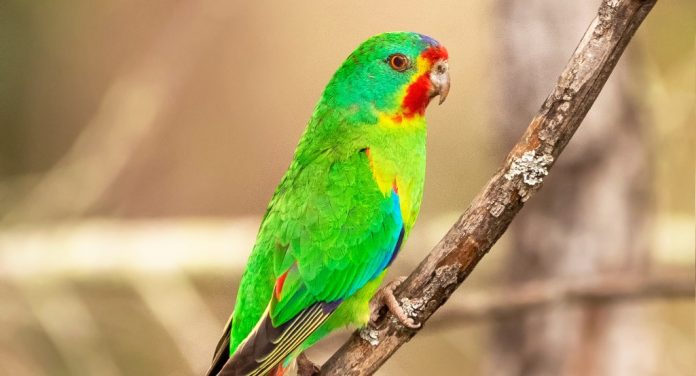Swift Parrot is a tree-living bird and is usually seen in small parties feeding on blossoms among the topmost branches of eucalypts or flying high overhead. These parrot’s visits to the ground are infrequent and only for drinking and for examining fallen seeds and flowers.
The parrots inhabit most types of timbered country and follow the flowering of its trees; they are regular visitors to gardens and parks and are often seen in trees lining the streets of towns and cities. Noisy birds, they appear to be always on the move, darting from one tree to the next, clambering about in the foliage or hanging upside down to get at blossoms, chattering all the while.
Their main food is pollen and nectar, particularly from eucalypt trees, and they follow the blossoming of various species. They also feed extensively on lerps, insects, and their larvae, as well as seeds, fruit including berries, and some vegetable matter. Swift Parrots breed in Tasmania and on some of the Bass Strait islands, migrate to the mainland between March and May and return to Tasmania in August and September.
Much of the movement seems to be at night. Some birds winter in Tasmania, but none has been recorded on the mainland in the summer. During the non-breeding season, the birds appear to concentrate mainly in southern and central Victoria; their appearance elsewhere is a result of dispersal.
During the breeding season, Swift Parrots may share a nesting tree with other breeding pairs. The details of their breeding cycle are not well known; most of what is known comes from studies of captive birds. In display, the male first bows and then draws himself up to feed the female. She alone broods, leaving the nest briefly in the morning and again in the afternoon to be fed by the male.
In courtship, he first bows to her, then draws himself up to feed her, by regurgitation. The nesting period is long and only one brood is reared a season. Fledglings undergo a partial molt into brighter plumage at a few months of age but do not acquire adult plumage until the following autumn.
Swift Parrots live up to their name, for their flight is extremely fast and direct on pointed, quick-beating wings. A flock moves with remarkable precision; as the birds pass overhead their rapid wing beats produce a whirring noise. The birds often mix with lorikeets and may then be difficult to identify.
They can be best recognized by their distinctive calls and, in flight, by the red under their wings and they are fine, pointed red-brown tails. Their similarities to lorikeets in appearance and feeding seem nonetheless coincidental.
Evidence that Swift Parrots have really arisen from rosella-like parrots comes from their single left carotid artery, submissive nape spot, variable underwing stripe, ladle-drinking, and clinking contact calls. Their tongues do have brush tips for mopping up nectar like a lorikeet, but the papillae are short and localized.
The other names are Swift Lorikeet and Red-shouldered Parakeet. The size of the Swift Parrot is about 250 mm in length, including a slender pointed tail. ADULTS: Sexes alike. The general plumage is mid-green, paler below. Crown dark blue; face red; lores and borders of face yellow; ear-coverts suffused with turquoise. The flanks and crissum are red with green markings.
Flight feathers blue-black edged with pale yellow; inner webs of tertiaries scarlet; underwing coverts, bend of wing and shoulders deep red. Central tail feathers dull brown-red tipped with blue; outer tail feathers dull blue edged with brown-red. Eyes are pale yellow and bill and cere horn. Their feet and toes are pale browns. IMMATURES: Duller than adults. The bird is less red on the throat and undertail coverts. Their eyes are brown.
Swift Parrot contact call, usually in flight, a metallic clink-clink, repeated quickly four or five times to produce a chirruping sound. Feeding accompanied by subdued rose/la-like chattering. All call-notes have a bell-like tone, unlike the screech of lorikeets. The breeding season starts in late September to early January.
Nest in a hollow limb or hole often high in a tree, usually a eucalypt. Eggs: three to five, usually four; white; rounded, 24-27 x 19-22 mm. Laid on wood dust. The incubation period is about 20 days, for females. Young fledge in about six weeks.
Most types of the timbered country where there are flowering trees. Breeds in Tasmania and migrates to the mainland for autumn and winter, reaching the Mt Lofty Ranges, SA, and following the east coast and the Great Dividing Range north to Fitzroy River drainage, Qld. No races.
Related Reading – Mulga Parrot









